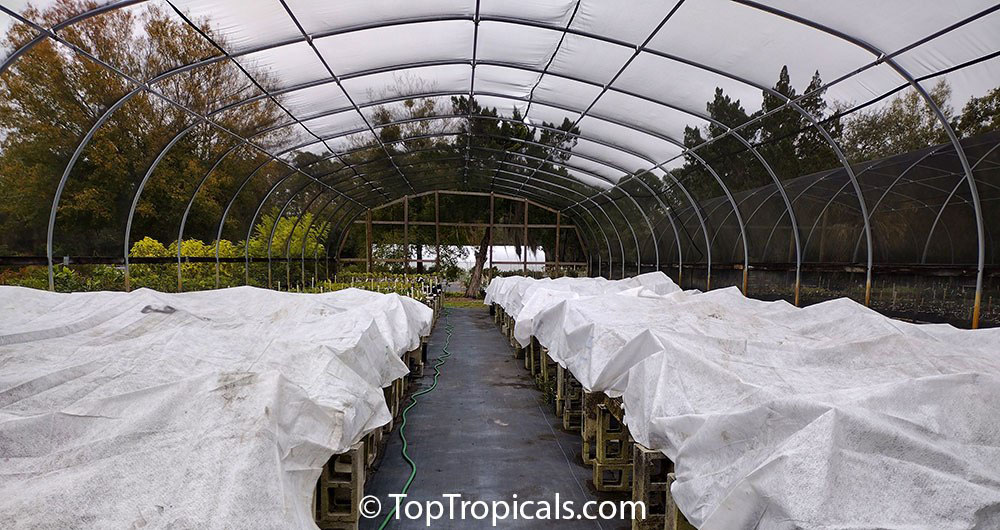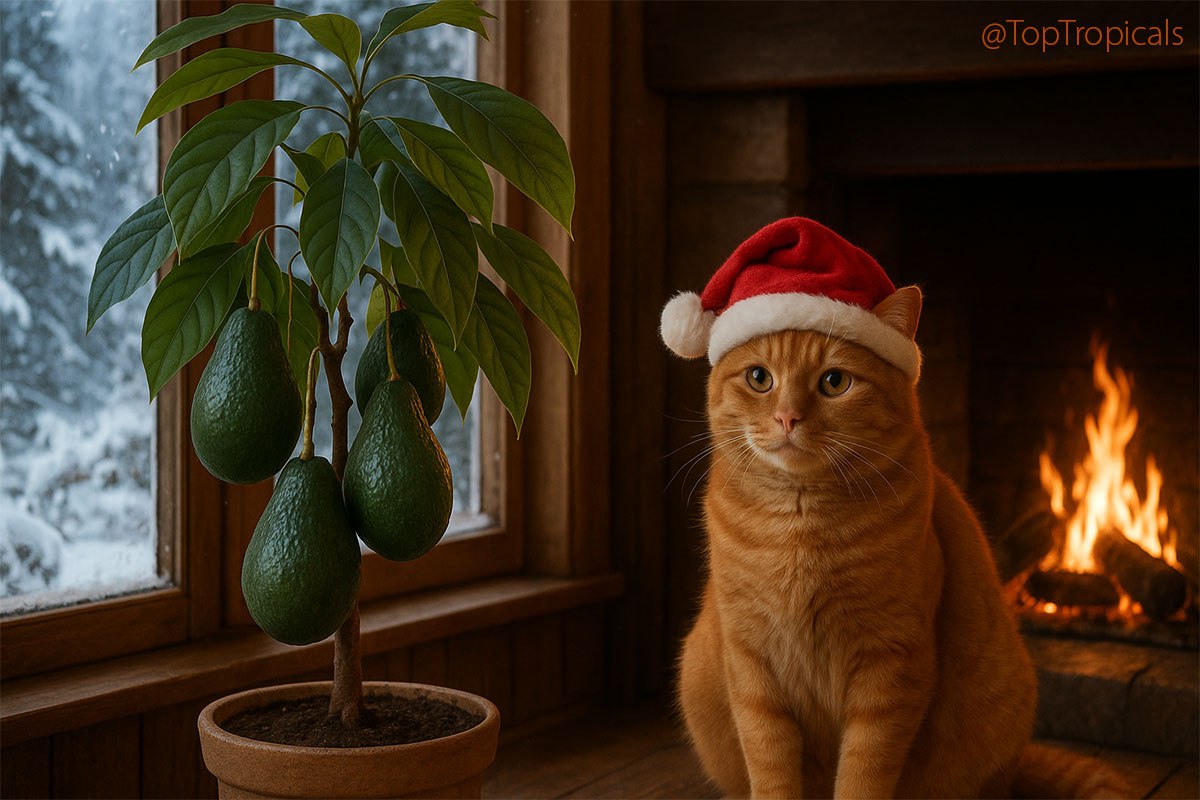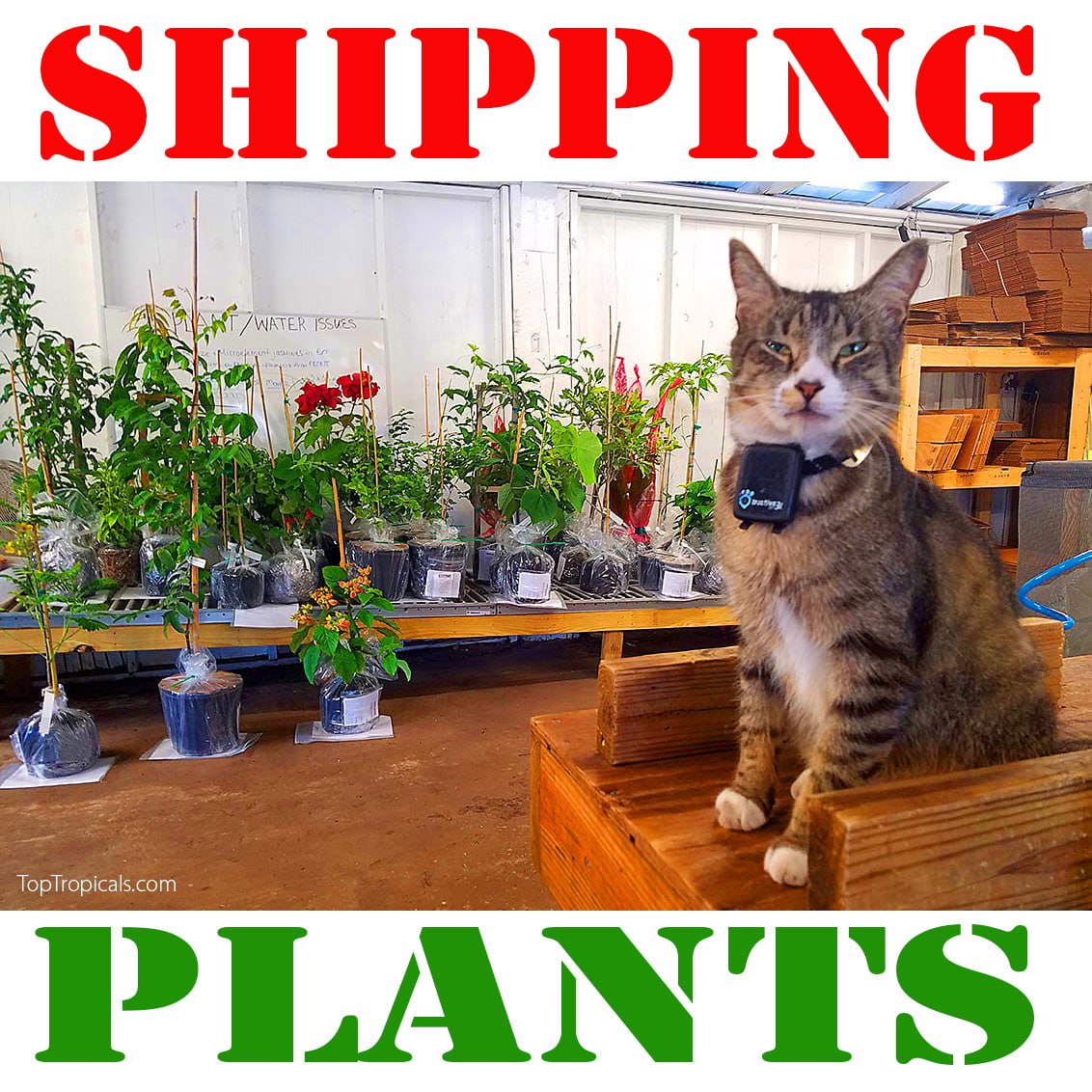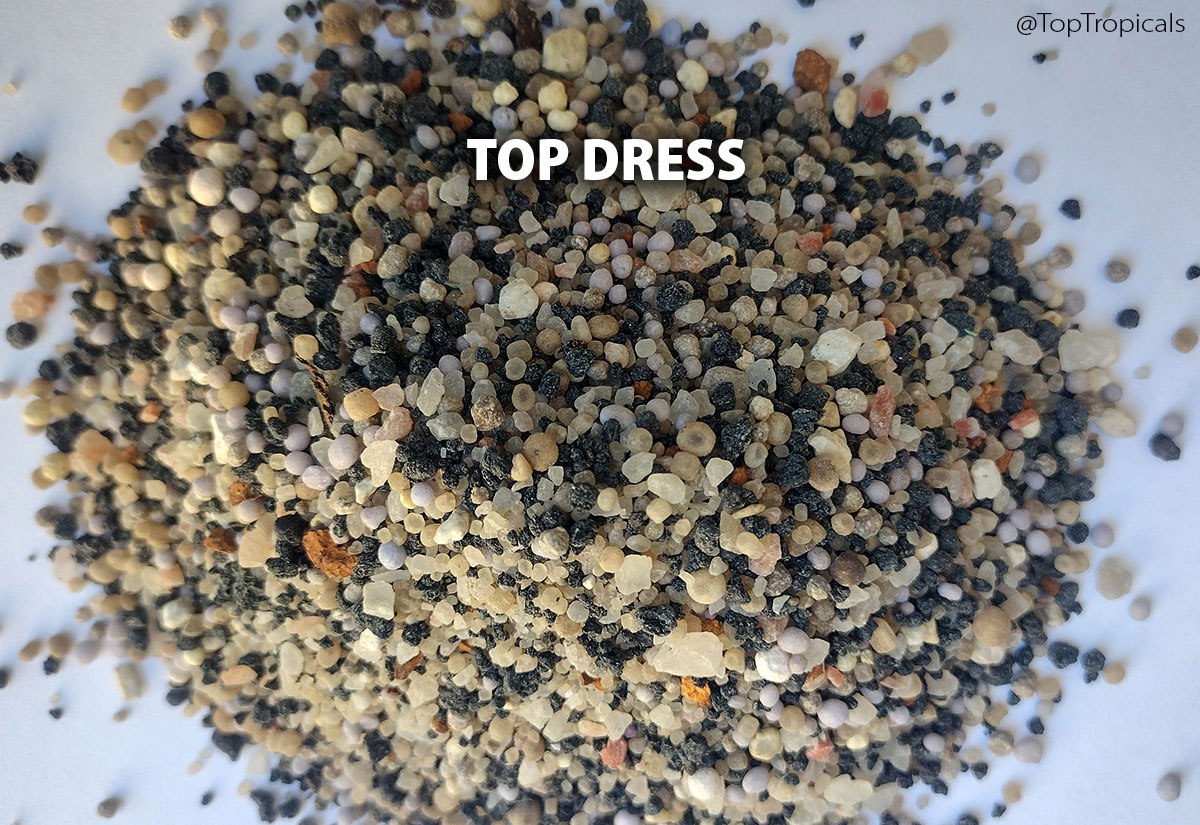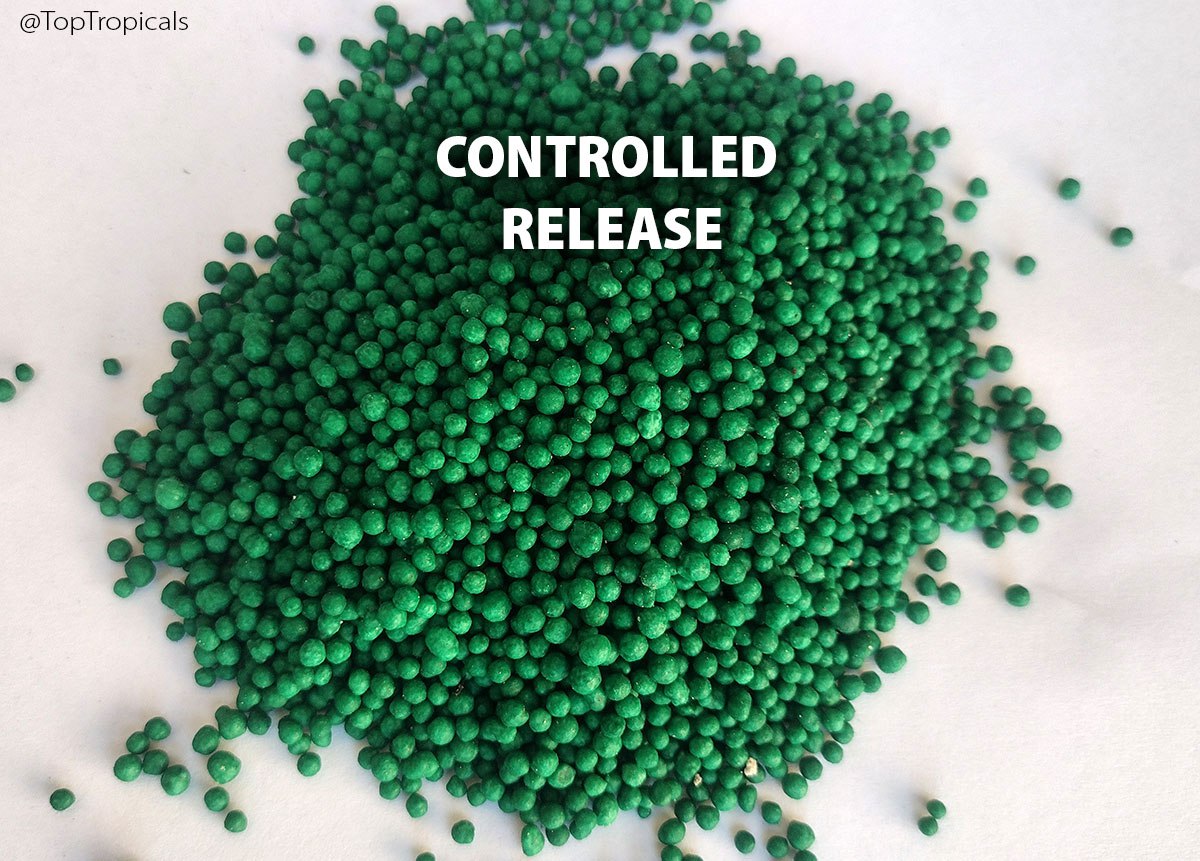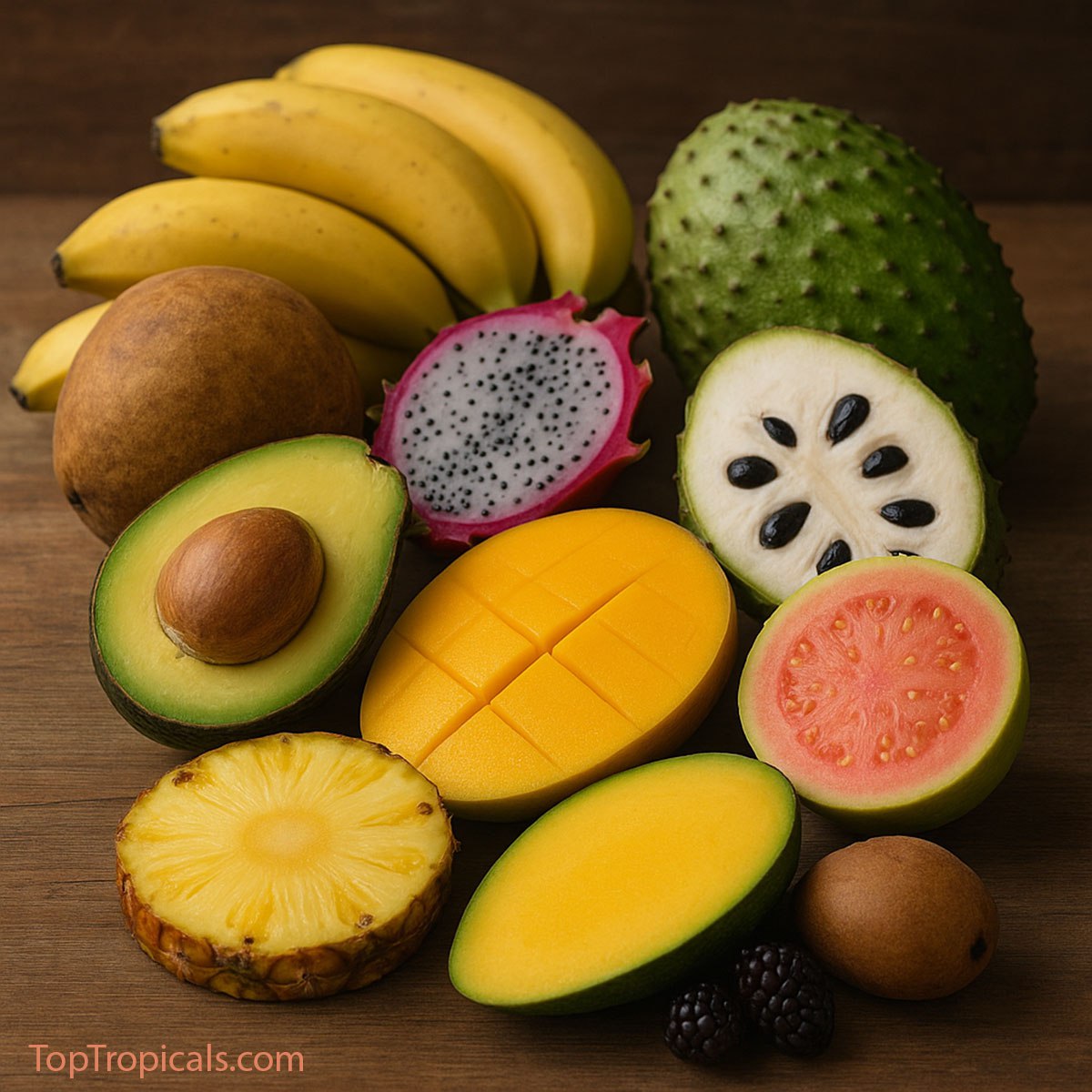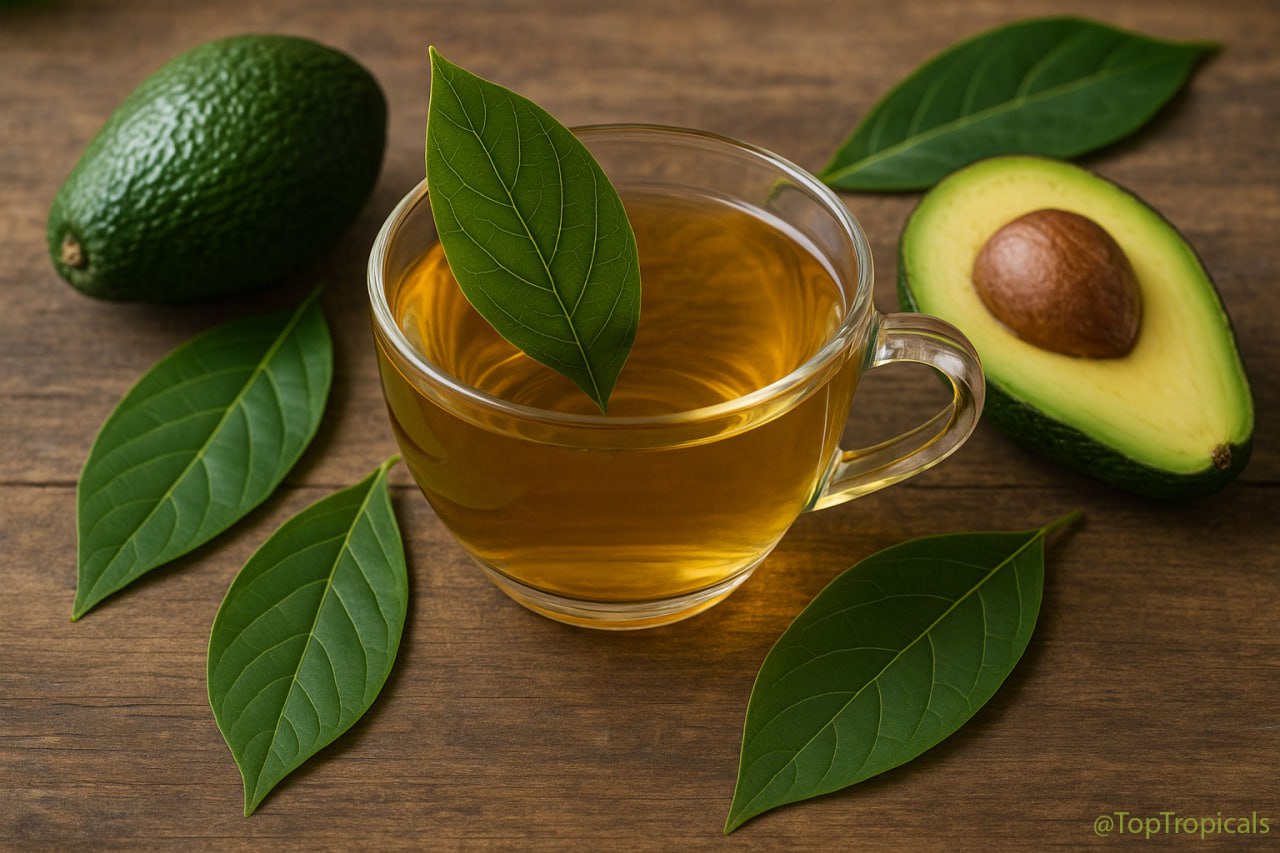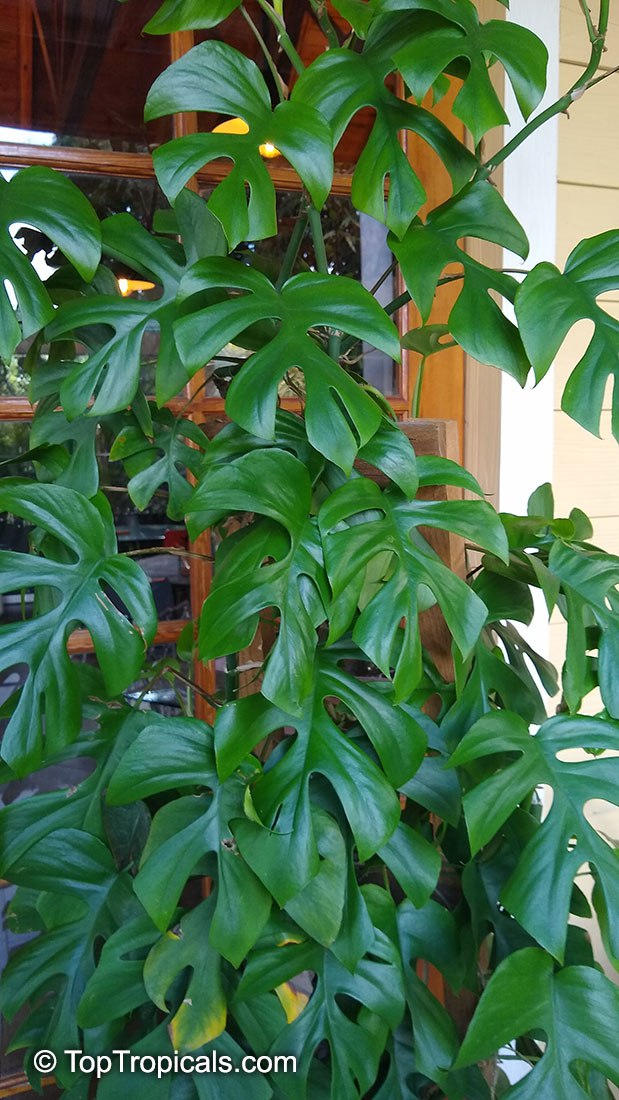Garden Blog - Top Tropicals
How to bring butterflies in your garden with Ditchmans Pipe
Aristolochia trilobata - Birthwort Dutchman's Pipe
How to bring butterflies in your garden with Ditchmans Pipe
🛒 Bring butterflies to your garden!
📚 Learn more:
#Butterfly_Plants #Hedges_with_benefits #How_to
🟢 Join 👉 TopTropicals
- 🐙 Aristolochia trilobata - Birthwort Dutchman's Pipe, is one of the most striking butterfly plants. The brown-and-green, pitcher-shaped flowers with long striped tails look like something from another world, and the glossy lobed leaves give the vine a bold, tropical look.
- 🐙 What makes this plant truly special is how butterflies respond to it. They are drawn to the scent of the flowers and use the vine as a host plant, laying their eggs on the leaves. If you want butterflies, this is one of the easiest ways to bring them in and support their full life cycle.
- 🐙 This vine is tough and adaptable. It grows well in subtropical climates, handles low light, and can even be kept indoors. Give it a trellis or a fence and it quickly turns into a showpiece.
- 🐙 Beautiful, unusual, and a butterfly favorite - Dutchmans Pipe is a natural magnet for life in your garden.
🛒 Bring butterflies to your garden!
📚 Learn more:
- ▫️Dutchman's Pipe - the best butterfly attracting vine
- ▫️Giant Pelican Flower
- ▫️Giant, coolest looking flower
#Butterfly_Plants #Hedges_with_benefits #How_to
🟢 Join 👉 TopTropicals
What to do and not to do before a cold snap?
What to do and not to do before a cold snap?
Growing tropical plants outdoors? Here are a few practical notes for your cold protection guide.
⭕️ 5 things to DO to prepare your plants before a cold snap:
1. Water well. A well-hydrated plant is stronger. Juicy stems and leaves handle cold better than dry ones.
2. Add mulch. A thick layer around the base helps insulate the roots and keep them warm.
3. Block the wind. Move pots to a sheltered spot or set up a windbreak.
4. Cover at night, uncover by day. Use frost cloth, blankets, or plastic at night - but remove during the day so plants don’t overheat in the sun and can get as much light as possible.
5. Add gentle heat if needed. Christmas lights or a small heater can help - just use caution and make sure everything is safe.
❌ 5 most common mistakes, what NOT to do before or during a cold snap:
1. Don’t prune. Fresh cuts and new growth are tender and will freeze first.
2. Don’t overwater. Cold and soggy roots can rot. Keep soil moist, not soaked. Water just enough to quench the plant’s thirst and fill stems and leaves with moisture. Cold and wet is a dangerous combination.
3. Don’t let plants dry out either. Wilted, thirsty plants are more likely to suffer cold damage. Cold and dry can be just as harmful as cold and wet.
4. Don’t use dry fertilizer. It can burn roots in cold soil. A gentle liquid feed like amino-acid Sunshine Boosters is an exception and safe to use with every watering. Its intake naturally slows down as watering decreases.
5. Don’t just watch the thermometer. Duration and wind chill matter. A long cold night with wind can do more harm than a brief freeze.
✔️ Keep these in mind, and your plants will thank you when the cold passes!
#How_to
🟢 Join 👉 TopTropicals
Growing tropical plants outdoors? Here are a few practical notes for your cold protection guide.
⭕️ 5 things to DO to prepare your plants before a cold snap:
1. Water well. A well-hydrated plant is stronger. Juicy stems and leaves handle cold better than dry ones.
2. Add mulch. A thick layer around the base helps insulate the roots and keep them warm.
3. Block the wind. Move pots to a sheltered spot or set up a windbreak.
4. Cover at night, uncover by day. Use frost cloth, blankets, or plastic at night - but remove during the day so plants don’t overheat in the sun and can get as much light as possible.
5. Add gentle heat if needed. Christmas lights or a small heater can help - just use caution and make sure everything is safe.
❌ 5 most common mistakes, what NOT to do before or during a cold snap:
1. Don’t prune. Fresh cuts and new growth are tender and will freeze first.
2. Don’t overwater. Cold and soggy roots can rot. Keep soil moist, not soaked. Water just enough to quench the plant’s thirst and fill stems and leaves with moisture. Cold and wet is a dangerous combination.
3. Don’t let plants dry out either. Wilted, thirsty plants are more likely to suffer cold damage. Cold and dry can be just as harmful as cold and wet.
4. Don’t use dry fertilizer. It can burn roots in cold soil. A gentle liquid feed like amino-acid Sunshine Boosters is an exception and safe to use with every watering. Its intake naturally slows down as watering decreases.
5. Don’t just watch the thermometer. Duration and wind chill matter. A long cold night with wind can do more harm than a brief freeze.
✔️ Keep these in mind, and your plants will thank you when the cold passes!
#How_to
🟢 Join 👉 TopTropicals
How to protect Avocado from cold and how hardy is it?
❄️ How to protect Avocado from cold and how hardy is it?
Growing Avocado trees in cooler regions is possible with the right variety and care. By choosing Cold Hardy types and protecting them during cold spells, you can successfully grow avocados outside tropical climates. The more mature your tree, the better it handles the cold.
❄️ Protection for young plants
With a little planning and protection, you can enjoy fresh avocados even in cooler climates!
✔️ Check outAvocado Variety Guide interactive chart. Sort them by flower type A or B, tree habit, fruit shape and quality, cold hardiness, origin, season and more!
🛒 Shop Cold Hardy Avocados
📖 Our Book: Avocado Variety Guide, Snack or Guacamole?
📚Learn more:
#Food_Forest #Avocado #How_to
🟢 Join 👉 TopTropicals
Growing Avocado trees in cooler regions is possible with the right variety and care. By choosing Cold Hardy types and protecting them during cold spells, you can successfully grow avocados outside tropical climates. The more mature your tree, the better it handles the cold.
- ❄️ What is Avocado cold hardiness?
Most Avocados are sensitive to frost, but some Mexican varieties can survive lows around 15°F once established, and brief dips near 10°F with good care.
- 👉 Cold tolerance depends on:
- ✦ Duration of cold: Short freezes are easier to survive.
- ✦ Sun exposure: More sun means better cold resistance.
- ✦ Wind protection: Wind can do more harm than temperature alone.
- ✦ Tree health: Regular fertilization, such as Sunshine Boosters, helps strengthen plants.
- ❄️ How to protect avocados from cold
- ✦ Bigger is better: Mature trees resist cold better than young ones.
- ✦ Wind protection: Plant on the south or southeast side of a building for warmth.
- ✦ Good fertilization: Healthy trees are stronger and more resilient.
- ✦ Watering: Water less in winter; overwatering in cold weather can cause root rot.
❄️ Protection for young plants
- ✦ Cover and mulch: Before a freeze, mound mulch around the base and cover with a blanket. Add Christmas lights or a small heater for extra warmth (use caution).
- ✦ Use microclimates: Plant near walls or buildings where it’s warmer and wind is reduced.
With a little planning and protection, you can enjoy fresh avocados even in cooler climates!
✔️ Check outAvocado Variety Guide interactive chart. Sort them by flower type A or B, tree habit, fruit shape and quality, cold hardiness, origin, season and more!
🛒 Shop Cold Hardy Avocados
📖 Our Book: Avocado Variety Guide, Snack or Guacamole?
- ·
📚Learn more:
- · Can I Grow Avocado Outside the Tropics?
- · Avocado Variety Guide
- · How to grow cold-hardy avocados and how cold-hardy are they?
- · Avocado that laughs at frost: Mexicola Grande for cooler climates
- · Cold hardy Avocado Joey: you can eat with the skin
- · Posts about #Avocado
#Food_Forest #Avocado #How_to
🟢 Join 👉 TopTropicals
How we ship plants: quick guide
🚚 How we ship plants: quick guide
If you’re a first-time mail order plant buyer, or just want peace of mind before sending a live plant on its journey in a box, check out these videos. And if you have questions, feel free to ask - we’ll be happy to answer them all!
Rest assured, your plants are in good hands!
🛒 Shop plants online
📚 Learn more:
#How_to
🟢 Join 👉 TopTropicals
If you’re a first-time mail order plant buyer, or just want peace of mind before sending a live plant on its journey in a box, check out these videos. And if you have questions, feel free to ask - we’ll be happy to answer them all!
Rest assured, your plants are in good hands!
- 📱 How do we ship plants? Part 1: prepare the plant
- 📱 How do we ship plants? Part 2: packing in the box
- 📱 How do we ship plants, Part 3: it's Christmas - unwrapping is fun?
🛒 Shop plants online
📚 Learn more:
#How_to
🟢 Join 👉 TopTropicals
Which dry fertilizer to use - slow release or controlled release?
🌳 Which dry fertilizer to use - slow release or controlled release?
❓ Q: You offer two kinds of dry fertilizers - Slow Release Trop Dress and Controlled Release Green Magic. What is the difference, and which one should I use? I used your water-diluted Sunshine Boosters with every watering, but now that I’ll be away for a few months, I just want to give my garden a long-lasting fertilizer.
Green Magic ideal for potted fruit trees, ornamentals, and houseplants. One handful keeps your plants fed for half a year. We use it for all container plants when potting up or refreshing soil every six months. It can also be used for in-ground plants if you want the best, most consistent results. Green Magic: try it out! (Sample here)
🛒 Shop Plant Food & More
📚 Learn more:
#Fertilizers #How_to
🟢 Join 👉 TopTropicals
❓ Q: You offer two kinds of dry fertilizers - Slow Release Trop Dress and Controlled Release Green Magic. What is the difference, and which one should I use? I used your water-diluted Sunshine Boosters with every watering, but now that I’ll be away for a few months, I just want to give my garden a long-lasting fertilizer.
- ✔️ A: Top Dress Slow Release Fertilizer is used for quick greening-up. Although it’s called “slow release,” the nutrients become available fairly fast. It contains soluble nitrogen (N), phosphorus (P), and potassium (K) that dissolve with rain or irrigation, acting within a week or a few weeks depending on temperature and rainfall. It’s great for giving your plants a quick boost of “fast food.”
- ✔️ Green Magic Controlled Release Fertilizer is a true long-term, controlled-release fertilizer. Thanks to its PolyOn Technology coating, it provides steady, consistent feeding for 5-6 months. Unlike regular dry fertilizers that dump all nutrients at once, Green Magic releases them gradually - no burn, no guesswork, just steady nutrition.
We use Top Dress mainly for in-ground plants. It can be used in pots only during warm weather and active growth, but not in cooler months, as it may burn roots. Since we introduced Green Magic, we mostly use Top Dress only for garden beds and landscapes.
Green Magic ideal for potted fruit trees, ornamentals, and houseplants. One handful keeps your plants fed for half a year. We use it for all container plants when potting up or refreshing soil every six months. It can also be used for in-ground plants if you want the best, most consistent results. Green Magic: try it out! (Sample here)
🛒 Shop Plant Food & More
📚 Learn more:
- ▫️Green Magic effect: before and after
- ▫️The SECRET growers never tell you: simple trick how to bring plants back to life and keep green
- ▫️Give your plants their magic treat
- ▫️How to make plants green quickly: Green Magic - the fertilizer that truly works like magic!
- ▫️How to to make leaves green
- ▫️What Fertilizer to Use Now and How? Part 1, Part 2, Part 3
- ▫️Why my plant turned yellow and why plants need Micronutrients?
- ▫️Why Should I Use Sunshine Boosters
- ▫️Why is my palm tree turning yellow?
- ▫️Which fertilizer to use: Organic or Inorganic?
- ▫️How to make plants green
- ▫️The Truth about fertilizers
#Fertilizers #How_to
🟢 Join 👉 TopTropicals
Cassia vs Bauhinia: which is better as an everblooming container tree?
Cassia vs Bauhinia: which is better as an everblooming container tree?
🌈 Cassia vs Bauhinia: which is better as an everblooming container tree?
🛒 Explore Cassia trees and Bauhinias (Orchid Trees)
📚 Learn more:
#Container_Garden #Trees #How_to
🟢 Join 👉 TopTropicals
- 🌸 Cassia (Senna) trees are very popular flowering trees - fast growing, free-flowering, relatively cold hardy, and they love the summer heat. Cassias come in several colors: yellow, orange, pink, red, and rainbow. Rainbow varieties (which are hybrids between yellow and pink cassias) are the most popular thanks to their multicolor blooms with swirls of yellow, pink, red, and orange. But while Rainbow Cassia is a spectacular flowering tree for southern gardens, is it a good choice for a container when you want color on your patio or pool deck?
- 🌸 Some yellow-flowering cassias make attractive bushes that bloom most of the year and stay compact, so they can be grown as container specimens:
- 🌸 When it comes to Rainbow or pink cassias such as Cassia javanica - Apple Blossom Tree or Cassia grandis- Red Cassia and other species and hybrids (Cassia marginata - Rainbow Shower Tree, Cassia roxburghii - Ceylon Senna, Cassia x nodosa - Pink Shower), these are usually more vigorous trees that may take several years to bloom. Their flowering season lasts from a few weeks to a couple of months. These trees grow moderately fast but typically need to reach about 10 feet before they start flowering.
- 🌸 So, the answer is: if you want rich, deep color year-round from a container tree, go with Bauhinias - Orchid Trees. Most varieties grow well in pots, stay compact, and reach blooming maturity within just one season. The following varieties are everblooming and can produce flowers for up to 10 months of the year:
Cassia didymobotrya- Popcorn Cassia
Senna alata - Empress Candles
Cassia fistula - Golden Shower (a compact size winter blooming tree)
- ▫️Bauhinia madagascariensis - Red Dwarf Orchid Tree. Blooms from winter through fall, up to 10 months a year. The most cold-hardy of all.
- ▫️Bauhinia blakeana - Hong Kong Orchid Tree. A large tree in the ground, but compact in pots if trimmed. Grafted trees flower right away. Winter bloomer, cold hardy to light frost.
- ▫️Bauhinia tomentosa - Yellow Orchid Tree. Flowers from Winter through Summer, cold hardy to light frost.
- ▫️Bauhiniamonandra - Napoleon's Plume Orchid Tree. Almost everblooming with the longest flowering period (less cold hardy than the first three).
- ▫️Bauhinia acuminata - Dwarf White Orchid Tree. Blooms from summer through winter (also less cold hardy than the first three).
🛒 Explore Cassia trees and Bauhinias (Orchid Trees)
📚 Learn more:
- ✦ How to add color to your yard with Cassias
- ✦ Rainbow Cassias and Why they are called "Rainbow"
- ✦ Napoleons Plume - Orchid Tree that blooms in a pot
- ✦ Bauhinia madagascariensis, or Red Butterfly Orchid Tree that NEVER Stops Blooming
- ✦ Rare Red Orchid Tree you may never find again but everyone wants
- ✦ Bauhinia acuminata, Dwarf Orchid tree - white and elegant
- ✦ 5 small tropical trees that bloom all summer or year around
- ✦ How to grow Orchid Trees in pots
#Container_Garden #Trees #How_to
🟢 Join 👉 TopTropicals
11 tropical fruits to eat instead of taking a fiber supplement
🍑 11 tropical fruits to eat instead of taking a fiber supplement
These fruits aren’t just delicious - they help you meet your daily fiber needs in ways that are far more enjoyable (and sustainable) than taking supplements. And when home gardeners, farmers, or tropical communities grow and share them, it’s a double win: nutrition and tradition hand in hand.
✔️ Tropical fiber power: tips for getting more fiber from tropical fruits
🛒 Plant a fruit tree to harvest your fruit tomorrow
📚 Learn more:
Tropical fruit health benefits guide - what fruit and edibles can help with health issues and vitamin deficiencies, Part 1 and Part 2.
#Food_Forest #Remedies #Discover #How_to
🟢 Join 👉 TopTropicals
- When we think of tropical fruit, we picture sweetness, sunshine, and exotic flavors packed with vitamin C. But beneath all that juicy goodness lies another gift: dietary fiber - quietly working to support digestion, feed the gut microbiome, and help keep blood sugar steady.
- Avocado leads the pack among tropical fruits for fiber content. One creamy, ripe fruit can provide around 10 grams of fiber, roughly a third of an adult’s daily need. And there’s more to avocado than fiber - it’s also rich in healthy fats, micronutrients, and that silky texture everyone loves.
- Other tropical fruits bring their own kind of fiber strength. Guava delivers up to 9 grams per cup, plus a burst of vitamin C.
- Mango offers about 3 grams in half a fruit, especially when eaten with some of the skin.
- Pineapple, though not always seen as a fiber powerhouse, still contributes around 2 grams per cup, along with bromelain, the enzyme that helps digestion.
- Jackfruit’s fibrous pulp makes it another standout - it’s so meaty, it’s even used as a plant-based substitute in savory dishes.
- Sapote fruit (Mamey, Canistel) and Sapodilla add fiber with a smooth, custard-like texture.
- Adventurous tropical varieties like Annona (custard apple, soursop) may not top the charts in fiber numbers, but their soft, fibrous flesh still adds value: about 1.3 grams of fiber per 100 grams of fruit.
- Bananas contain both soluble and insoluble fiber; the soluble part (mainly pectin) helps control blood sugar and appetite, while the insoluble fiber aids regularity.
- Mulberries are rich in insoluble fiber, especially in their skin, supporting digestion and promoting healthy bowel movements.
- Dragon fruit offers a mix of soluble fiber in its juicy flesh and insoluble fiber from its tiny edible seeds, which help support gut health and feed good bacteria.
These fruits aren’t just delicious - they help you meet your daily fiber needs in ways that are far more enjoyable (and sustainable) than taking supplements. And when home gardeners, farmers, or tropical communities grow and share them, it’s a double win: nutrition and tradition hand in hand.
✔️ Tropical fiber power: tips for getting more fiber from tropical fruits
- ⏺Eat whole, not juiced. Most of the fiber is in the pulp, skin, and seeds. Juicing removes much of that goodness.
- ⏺Mix it up. Tropical fruits are great, but balance them with legumes, whole grains, nuts, and veggies for a full fiber range.
- ⏺Take it slow. If your diet is low in fiber, increase gradually to avoid bloating or discomfort.
- ⏺Drink plenty of water. Fiber works best when paired with hydration.
- ⏺Mind the ripeness. Unripe fruits can have more resistant starch, another form of fiber.
- ⏺Get creative. Toss tropical fruits into smoothies, salsas, breakfast bowls, or even desserts - a tasty stealth-fiber strategy.
🛒 Plant a fruit tree to harvest your fruit tomorrow
📚 Learn more:
Tropical fruit health benefits guide - what fruit and edibles can help with health issues and vitamin deficiencies, Part 1 and Part 2.
#Food_Forest #Remedies #Discover #How_to
🟢 Join 👉 TopTropicals
Avocado leaf tea: island secret for a calm heart and blood pressure
Avocado leaf tea: island secret for a calm heart and blood pressure
🛒 Plant an Avocado tree and help your body stay healthy
📚 Learn more:
Tropical fruit and plants that help keep blood pressure in balance, Part 1, and Part 2.
#Food_Forest #Remedies #Discover #How_to
🟢 Join 👉 TopTropicals
🍃 You see that Avocado tree in your yard? Don't just love it for the fruit - the leaves carry magic too! Old folks in the tropics will tell you - never throw away the avocado leaves. They’ve been used for generations to brew a tea that helps steady the heart and ease high blood pressure.
🍃 When life gets busy and your heart starts beating too fast, this tea helps it find its rhythm again. The leaf holds flavonoids and quercetin - fancy words for what nature been doing all along: keeping the blood flowing smooth and the body at peace. Folks say it also helps with digestion and keeps the liver happy.
🍃 Avocado leaf tea
Ingredients
- 3 to 4 fresh avocado leaves
- 2 cups water
- Optional: honey, lemon, or cinnamon stick
Instructions
- Rinse the avocado leaves well.
- Place them in a small pot with 2 cups of water.
- Bring to a gentle simmer and let it cook for about 10 minutes.
- Strain the tea and add honey, lemon, or cinnamon if desired.
- Sip slowly and enjoy the calm, earthy flavor.
- 🍃 They say it helps the belly, calms the mind, and keeps the liver strong. Maybe that’s science, maybe it’s just island truth - but it surely does the body good! Some call it bush medicine, others just call it good sense. Either way, it’s a simple garden remedy that’s been soothing hearts long before pills and prescriptions came around.
🛒 Plant an Avocado tree and help your body stay healthy
📚 Learn more:
Tropical fruit and plants that help keep blood pressure in balance, Part 1, and Part 2.
#Food_Forest #Remedies #Discover #How_to
🟢 Join 👉 TopTropicals
Stop watering your Monstera on a schedule - here is what it really wants!
💦Stop watering your Monstera on a schedule - here is what it really wants!
📸 In the photo: Rhaphidophora tetrasperma - Mini Monstera, Dwarf Monstera Ginny, a rare collectible for plant enthusiasts.
🛒 Shop Monstera plants
📚 Learn more:
#Food_Forest #Container_Garden #Shade_Garden #How_to
🟢 Join 👉 TopTropicals
☘️ Monstera might look like a big diva, but it's actually one of the easiest houseplants to keep happy, according to the gardening experts from Southern Living.
☘️ The trick is not sticking to a strict watering schedule, but checking the soil. Water only when the top couple inches feel dry - usually every week or two in warm months and less in winter. Give it a good soak until water drains out the bottom, then let it dry again.
☘️ Too much water is worse than too little – soggy soil means root rot. Signs of overwatering include yellow or droopy leaves, dark spots, or gnats buzzing around. Underwatering looks similar, but the soil will be bone dry. When in doubt, check the dirt!
☘️ You can water from the top or let the pot sit in a shallow tray to soak from the bottom – just don’t let it sit in water. Bright, indirect light and a well-draining pot are your best friends. Keep that balance, and your Monstera will thrive for decades.
📸 In the photo: Rhaphidophora tetrasperma - Mini Monstera, Dwarf Monstera Ginny, a rare collectible for plant enthusiasts.
🛒 Shop Monstera plants
📚 Learn more:
- • Fruit growing on a house plant!
- • How to harvest and eat Monstera Ice Cream
- • How mini is Mini Monstera?
- • Holy Swiss Cheese Plant
- • Monstera x adansonii - Baby Swiss Cheese Plant
#Food_Forest #Container_Garden #Shade_Garden #How_to
🟢 Join 👉 TopTropicals
Yes, you can grow a tropical fruit tree in a pot!
Yes, you can grow a tropical fruit tree in a pot!
If you live where winters get chilly, move the pot indoors or into a greenhouse before frost. Prune lightly in spring to keep shape and airflow. Container trees can fruit heavily if given light, warmth, and consistent care.
At the end of the day, container culture lets you grow the tropics anywhere - from a city balcony to a backyard deck.
➡ Next: The best tropical fruit trees for containers...
📸 Growing and fruiting Soursop in apartment (PDF download)
🛒 Explore tropical fruit trees
#Food_Forest #How_to #Discover
🟢 Join 👉 TopTropicals
🍒 If you dream of picking fresh tropical fruit - Mango, Avocado, exotiс Annona and more - but only have a patio, balcony, or small yard, you’re not out of luck. Many tropical fruit trees grow perfectly well in large containers. The key is choosing the right variety, pot, and care routine.
🍒 Pick a compact tree type
🍒 Choose the right pot
🍒 Soil and watering
🍒 Light and feeding
🍒 Cold protection and pruning
Start with a dwarf or semi-dwarf variety. Regular tropical trees can grow huge, but container-sized cultivars stay under 8–10 feet and are much easier to manage. For example, Condo varieties of Mango like Pickering or Ice Cream stay small and still produce full-sized fruit. The same goes for Dwarf Avocados like Wurtz (also called Little Cado) and Sugar apples. Blackberry Jam fruit tree (Randia formosa) and Peanut Butter Fruit tree (Bunchosia argentea) are also excellent choices.
Begin with a 5-gallon container and move up as the tree grows. A mature plant will be happy in a 20–25-gallon pot. Drainage is critical - roots will rot if the pot stays soggy. Use a sturdy plastic, ceramic, or wooden container with multiple holes in the bottom.
These trees all like loose, well-draining soil. Mix potting soil with perlite or pine bark for better aeration. Water deeply but not too often - let the top few inches dry before watering again. Overwatering is the quickest way to kill a potted tropical.
Full sun is a must - aim for at least 6 hours daily. Fertilize during the growing season with a balanced fruit tree or slow-release fertilizer like Green Magic or liquid Sunshine Boosters. Many tropicals appreciate an extra boost of micronutrients like iron and magnesium to keep their leaves green.
If you live where winters get chilly, move the pot indoors or into a greenhouse before frost. Prune lightly in spring to keep shape and airflow. Container trees can fruit heavily if given light, warmth, and consistent care.
At the end of the day, container culture lets you grow the tropics anywhere - from a city balcony to a backyard deck.
➡ Next: The best tropical fruit trees for containers...
📸 Growing and fruiting Soursop in apartment (PDF download)
🛒 Explore tropical fruit trees
#Food_Forest #How_to #Discover
🟢 Join 👉 TopTropicals

